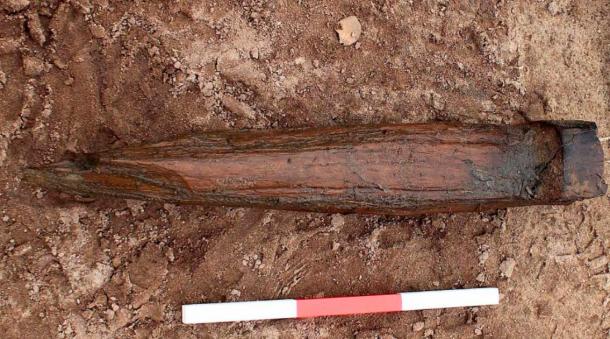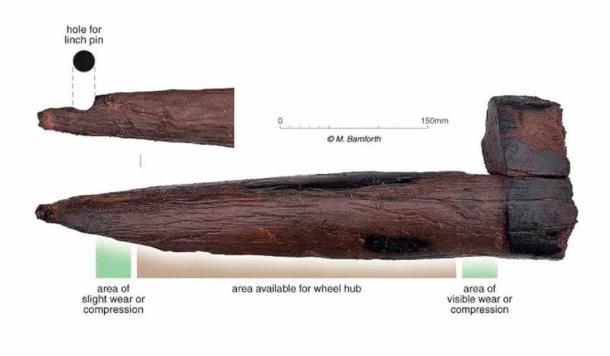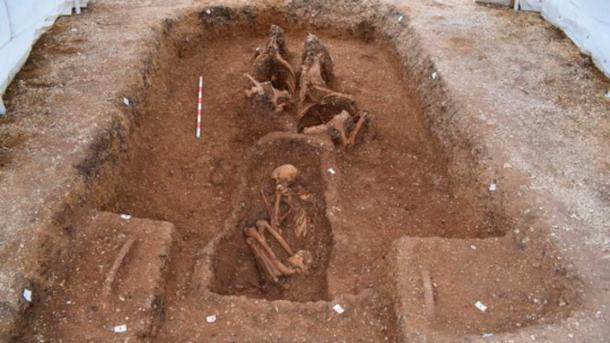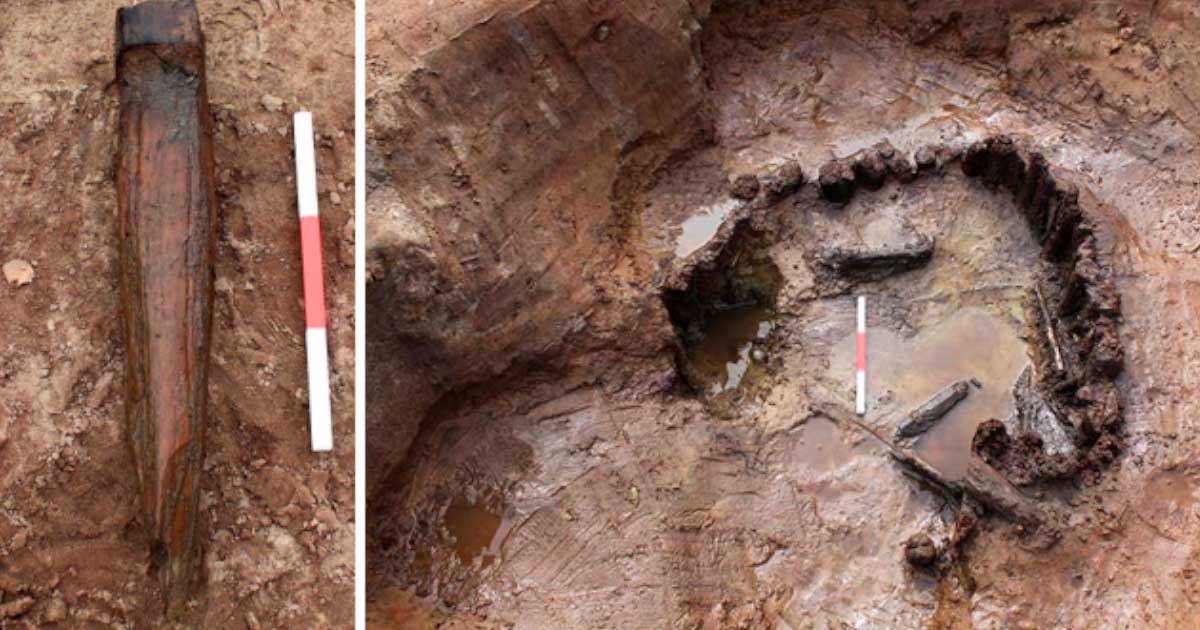Iron Age Chariot Axle Offers A Rare Example of Prehistoric Technology
An "exceptionally rare" Iron Age wooden axle from a chariot or cart has been found in a waterlogged pit in Eastbridge, Suffolk. The fragment was uncovered ahead of tree planting for the Sizewell C nuclear power station project. A radiocarbon date on the hazel wood of the axle has shown that it was made between 400BC and 100BC.
The discovery was made by Cotswold Archaeology in 2021, and joins a handful of others from British later prehistory, such as the axle found at Flag Fen in Peterborough.
The team had found examples of prehistoric to medieval archaeology, including two Iron Age pits that were most likely used as watering holes for livestock. Both pits were waterlogged, providing ideal preservation conditions for wood, and it is in the base of one of these that the axle was found.

The wooden axle repurposed as a stake. (Cotswold Archaeology)
Proof Recycling, Reusing, Repurposing is Nothing New
According to the BBC, the fragment has just been identified through analysis by dendrochronologist Michael Bamforth, a research associate at the University of York.
The axle was broken and burned in antiquity, and found together with charred boards that were possibly from the same vehicle. However, it had been repurposed within a stake shoring that had prevented the collapse of the waterhole in the site’s sandy soil.
This axle is an exceptionally rare find that joins only a handful of others from British later prehistory, such as the axle found at Flag Fen, Peterborough.
Research is ongoing to determine more of what this fascinating piece means for our understanding of prehistoric vehicles and transport.

The wooden axle repurposed as a stake. (Cotswold Archaeology)
Clues to Ancient Transit
The discovery of this wooden axle is an important one for archaeology, as it provides insight into how ancient civilizations in Britain transported goods and people. The fact that it was found in a waterlogged pit, along with charred boards, suggests that it was part of a larger vehicle, possibly a chariot or cart. The preservation of the wood is also significant, as it allows researchers to study the construction and design of these ancient vehicles. It provides valuable information on the technology of transportation in ancient times.
- Headless Horses Galloping from the Grave Unearthed in UK Chariot Burial
- Three Chariots in India Suggests Warrior Class of Ancient Civilization

Image of horses and chariot found in Pocklington, Yorkshire in 2018. (MAP Archaeological Practice)
British Chariot Burials
Although this is not part of a burial, it can be viewed in the context of the famous chariot burials of the Iron Age in Britain, such as those from Wetwang in East Riding, although there are big differences between the finds, one being that no wood survived in the graves.
British chariot burials refer to the practice of burying chariots and their associated artifacts in the Iron Age of Britain, typically dating from the later prehistory period between 800 BC and the Roman conquest in 43 AD, when the practice seems to have fizzled out.
Along with the chariot, artifacts could include harnesses, wheels, and other fittings, as well as the remains of horses and other animals that were used to pull the chariot. These burials are considered to be of high status and were likely reserved for the elite members of Iron Age societies.
The best-known examples of chariot burials in Britain are those from Wetwang, East Riding of Yorkshire, where the remains of at least 17 chariots have been found. Other notable examples include the burials at Barrow Clump, Wiltshire and the Flag Fen, Peterborough.
A discovery of chariot burials in Ferrybridge and Newbridge Chariot found in Edinburgh are distinctive as they were buried in their entirety. The Pocklington, Yorkshire example in the image above is another fine and well-preserved example, which also included the remains of the horses used to pull the vehicle.
More recently, the metal fragments of a chariot wheel found as part of a chariot burial in Pembrokeshire, Wales in 2018
The discovery of a wooden axle fragment in Eastbridge, Suffolk in 2021 is considered an exceptionally rare find that adds to the current understanding of prehistoric vehicles and transportation in Britain.
Top image: The chariot axle and the Iron Age pit in which it was found. Source: Cotswold Archaeology
By Gary Manners


















Comments
The question is, how did they perform the carbon-dating? To do it right, they would have to get the sample from the very center of the wood piece, not the surface. We know they tend to date objects from the surfaces and sediments, which is really a meaningless or deceptive way to do it. But I guess it is possible, however unlikely, that the piece sunk down there and remained somewhat integral. But at some point somebody in the industry will ‘float out’ the theory that there was a pre-Ice Age civilization up there that was decimated by the Atlantis event, and rapidly-following Ice Age.
Nobody gets paid to tell the truth.
You might be right on that Pete, but this was found in a waterlogged pit, not a bog.
Gary
It’s NOT possible for wood from the Iron Age to have sunk down into a bog, been preserved and still exist. Bogs were created at the start of the Ice Age (circa 115k BC), when plant matter died/buried/submerged quickly, before the oxygen and bacteria could decompose it. They need to come up with another explanation.
Nobody gets paid to tell the truth.